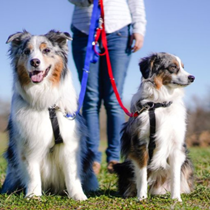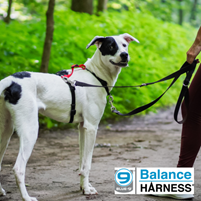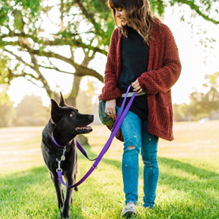Imagine you are preparing for a leisurely walk with your four-legged friend, ready to enjoy the outdoors together. But as soon as you step outside, your pup’s excitement takes over, turning what should be a relaxing stroll into a tug-of-war.

Comfortable dogs being walked with Y-shaped harnesses.
Dealing with a dog that pulls relentlessly on the leash isn’t just an inconvenience; it can have an impact on your dog’s well-being. The good news is that there’s a solution: selecting the right harness. You can regain control and transform frustrating walks into enjoyable adventures. Let’s explore the different types of harnesses and how they can help. There are three common design types for walking harnesses: step-in, Y-shaped, and cross-chest.
Step-in harnesses are popular because they are easy to put on. Your dog simply steps into the harness, and you pull it up and snap it together. Step-ins typically have one connection point on the back, where the neck and chest pieces meet with D rings for leash attachment. Step-in harnesses made of mesh webbing with padding are a comfortable choice for small and smooth-coated dogs. However, they can rub the armpits if not properly padded, and they offer less adjustability. Snugly fitted step-in harnesses can also press uncomfortably against the spine. And that back-clip-only option tends to increase pulling for some dogs who love to lean into the pressure (think of an ox working while harnessed).

Dual connection points are a snap with the Blue-9 Balance Harness.
Y-shaped harnesses feature a single strap that fits between the front legs and attaches to a strap around the ribcage. The Blue-9® Balance harness, made of nylon webbing, is a good example of this style. There are two places to connect your leash – below the dog’s neck and on their back. If you connect the leash to both points, the front clip helps turn the dog if they pull, and then you can relax the front end of the leash while maintaining the back connection. Compared to other “no-pull” equipment, Y-shaped harnesses allow for more front leg range of motion.
The cross-chest harness is named for its horizontal strap that fits between the dog’s neck and sternum, parallel to the ground. Some brands have a loop on the cross-chest strap that tightens when pulled. Trainers who prefer to have more control over their dogs and restrict front leg movement often favor this style. While cross-chest harnesses can be helpful as a short-term training tool, it’s important not to overuse them.

Off to a great start with the right harness!
Research cited on the Blue-9® blog suggests that prolonged use of a cross-chest harness may lead to physical issues. Cross-chest harnesses may not be suitable for puppies whose bodies are still growing, as they can put additional stress on muscles and joints. Y-shaped harnesses are a better option for puppies, as they distribute pressure more evenly and do not pull the shoulders together.
Finding the perfect harness for your dog’s walking needs can be a game-changer, transforming your walks into enjoyable experiences for both of you. By considering the different harness designs and selecting one that suits your dog’s body type and preferences, you can gain better control and make your walks easier on you and your dog!






 Phone:
Phone: